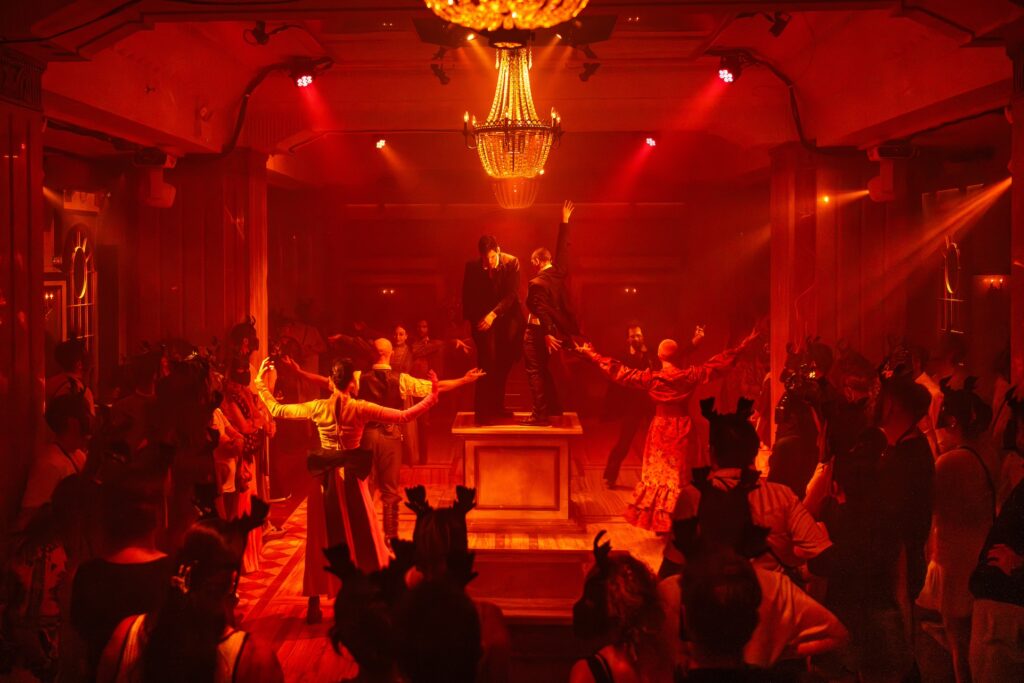Fans of Immersive Theater May Rejoice, as a Follow-Up to the Hit ‘Sleep No More’ Arrives at New York
‘Life and Trust’ slots a bevy of characters modeled after historical figures into more than 20 stories, which unfold over six freshly renovated floors of a skyscraper in the financial district. Good luck keeping up with it all.

Back in 2011, a U.K. theater company, Punchdrunk, took New York by storm with “Sleep No More,” an immersive production inspired by “Macbeth” and with nods to Hitchcock films. Over the course of three hours, attendees could roam through a succession of often dimly lit rooms and corridors that had once been nightclub spaces, following a bevy of attractive young performers as they enacted storylines littered with sex and violence — wordlessly, for the most part, with movement and spectacle serving as the primary means of expression.
“Sleep” is scheduled to end its run in September, but those craving more of the above can rest assured: Emursive, the company that brought the show to our country, has just unveiled a largely homegrown follow-up. Titled “Life and Trust” and conceived with the British author Jon Ronson, it slots a bevy of characters modeled after historical figures (noted and obscure) into more than 20 stories, which unfold over six freshly renovated floors of a skyscraper in the heart of Manhattan’s financial district; it’s literally a towering testament to American excess.
That’s ironic, because in essence, “Life” denounces such excess. Unfolding on the brink of the stock market crash of 1929, then dipping back several decades into the Gilded Age, it melds together different variations on the Faust legend, introducing us to a tycoon who makes a pact with the devil so that, while Wall Street collapses, he can travel back in time.
After converging in a vast, stylish bar area where cocktails with names like Devil’s Dummy and Sleep No More are served, theatergoers are invited to meet J.G. Conwell, namesake of the building, Conwell Tower — yes, the venue has been titled for the show — and chairman and CEO of the fictional Life and Trust Bank. Ostensibly, J.G. is courting them as clients, but once they’re guided into his lair, he delivers a more personal tale.

As ominous music is pumped into the room, J.G. discloses how, as a young man, he crossed paths with a mysterious, enchanting figure, a magician proffering a green syrup that could cure the physical pain and anxiety plaguing J.G.’s delicate sister, Naima. It was this obviously addictive narcotic that first allowed him to make his fortune, much as the Sackler family would do roughly a century on.
Moments after this revelation, audience members are asked — ordered, really — to strap on black masks (attendees of “Sleep” are given white ones) with sinister-looking antlers. By this point, anyone who isn’t in the cast or crew has been stripped of belongings; coats, bags, and purses are not allowed in the performance spaces, and phones can only be carried locked up in sacks, lest someone be tempted to take photos — or call for help.
Those wishing to leave early may also consult one of the silent but friendly ushers scattered about each floor; others can spend the next two hours or so wandering up and down stairs and from room to room, taking in one creepy, unsmiling vignette after another: A Houdini-like sorcerer repositions the limbs of seemingly entranced men and women, sometimes planting suggestive red cards. An agonized Naima rips open her dress and writhes on her bed; in a seedy-looking laboratory, another woman appears to chloroform a man and then places leech-like objects on his chest.
If you’re sensing a whiff of sexual sadomasochism, that’s not by accident. Like “Sleep,” “Life” appeals to our most voyeuristic instincts — albeit with an artsy patina that may make you feel more virtuous than, say, surfing porn websites. The cast members, who alternate in some two dozen roles ranging from vaudeville tramps to eugenicists, help each other change clothes; obviously trained dancers, they spin and swoon through routines — choreographed by Jeff Kuperman and Rick Kuperman, who also assist director Teddy Bergman, with additional “movement direction” by Stefanie Batten Bland — that blur the line between eroticism and brutality.
If you tire of ogling the performers, Grace Laubacher’s scenic design is equally striking, combining richly detailed, period-savvy furnishing with a fittingly creepy air of decay. Whether taking in a ravishing mini-theater replete with dozens of seats or touring lushly appointed rooms, I found myself pondering that question that has forever plagued us under capitalism — not what price greed and materialism exact on our souls, but rather: “Jeez, how did they pay for all this stuff?”
Be warned that like “Sleep,” “Life” is packed with more activity than can be absorbed in one performance, some of it physical. It can involve chasing actors from floor to floor, even as other players move in the opposite direction, with hordes of masked fans running past each other like misguided armies. That’s to say nothing of the strobe lights, haze, and laser effects that compete with period music and other, more vexing sounds, climaxing in a finale that’s as much of a sensory assault as any number in “Back to the Future: The Musical.”
Theatergoers can return for repeat viewings of “Life and Trust,” as many have for “Sleep,” if they have the energy and the will — and the money. Given Conwell Tower’s location, I don’t expect the last factor, at least, will pose much of a hurdle.

